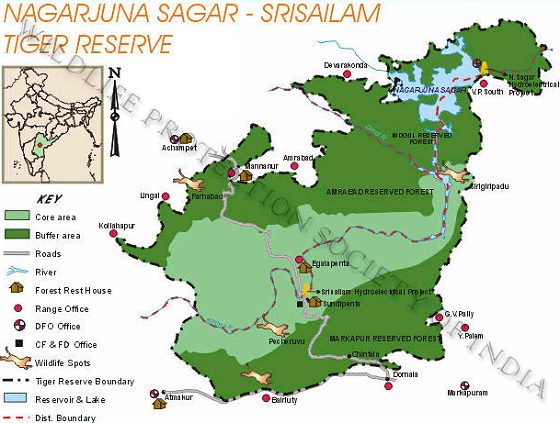Tiger Reserves
| |
|
|

|
|
Nagarjunasagar
Tiger Reserve
|
|
State
|
Andhra
Pradesh
|
History
|
|
Altitude
(above M.S.L)
|
100
- 917 m
|
Before
India’s independence in 1947, the southern
half of this reserve was controlled by the
British whereas the northern half was the
royal hunting grounds of the rulers of Hyderabad.
The area was notified as Nagarjunasagar-Srisailam
Sanctuary in 1978 and renamed Rajiv Gandhi
Wildlife Sanctuary in 1992. It was declared
a Tiger reserve in 1983.
|
|
Area
|
Total
|
3568.1
km²
|
|
Core
|
1200.0
km²
|
|
Buffer
|
2368.1km²
|
|
Flora
and Fauna
|
|
This
region receives rain from the south-west
and the north-east monsoons, resulting in
a long wet season. During this time wildlife
is generally confined to the plateaus. During
summer water is scarce therefore forcing
the animals to move to the valleys. An estimated
39 tigers are found at Nagarjunasagar.
|
|
Temperature
|
16°C
- 43°C
|
|
Rainfall
(per annum)
|
1000
mm
|
|
Seasons
|
Winter
|
Nov
- Feb
|
|
Summer
|
Mar
- Jun
|
|
Monsoon
|
Jun
-Nov
|
|
Fauna
|
|
Tiger,
leopard, sloth bear, wild dog, jackal, spotted
deer, mouse deer, black buck sambar, blue
bull, chinkara, chousinga, wild boar, pangolin,
mugger, python, cobra, etc.
|
|
Forest
Types
|
|
Southern
Tropical Dry Mixed Deciduous Forests, Hardwickia
Forest, Southern Thorn Forests, Southern
Euphorbia Scrubs
|
|
Funds
|
Insufficient
& late
|
Management
Objectives
|
|
Staff
|
Untrained
& understaffed
|
Environmental
protection is the main priority. Water and
fire management, as well as habitat improvement
are important activities
|
|
Problems
|
|
Extremists
are active in the reserve. Poaching of animals
is rare but timber smuggling is common.
Trees are also felled for easier access
to Adda leaves, which are used. to
make leaf plates. 550 local families are
dependent on this industry. Grazing is another
problem in the reserve.
|
|
External
Influences (1991 census)
|
|
Villages
|
200
|
|
Population
|
169,000
|
|
Livestock
numbers
|
360,000
|
|
|

|
|